Dog Agility Training on Cape Cod
At Joseph’s Dog Training School, we offer comprehensive dog agility training programs designed to challenge your dog physically and mentally. Whether you’re new to agility or looking to sharpen your dog’s skills, our classes are tailored to all experience levels. Located in Pocasset MA on Cape Cod, we proudly serve dog owners across the region, helping their pets build confidence, improve focus, and strengthen the bond with their handlers.

Why Choose Agility Training for Your Dog?
Dog agility training is not just a fun activity—it’s a powerful way to enhance your dog’s physical and mental health. Here are some key benefits:
- Improves Physical Fitness: Agility courses challenge your dog to navigate tunnels, jumps, and weave poles, promoting strength, coordination, and endurance.
- Boosts Mental Stimulation: The problem-solving required during agility training keeps your dog’s mind sharp and engaged.
- Strengthens Bond with Handlers: Working as a team in agility courses fosters trust and communication between you and your dog.
- Builds Confidence: Conquering obstacles increases your dog’s self-assurance, making them more adaptable in various situations.
Our Agility Training Program
At Joseph’s Dog Training School, we provide structured classes tailored to your dog’s age, breed, and skill level. Whether your dog is a beginner or an experienced competitor, we are here to guide you through the process.
What You’ll Learn in Our Agility Classes:
- Introduction to Equipment: Teach your dog to navigate tunnels, jumps, A-frames, and weave poles.
- Problem-Solving Exercises: Engage your dog’s mind with challenges that test their focus and decision-making.
- Teamwork Skills: Strengthen the connection between you and your dog as you work through agility courses together.
- Our agility training emphasizes positive reinforcement, ensuring your dog learns in a supportive and enjoyable environment.
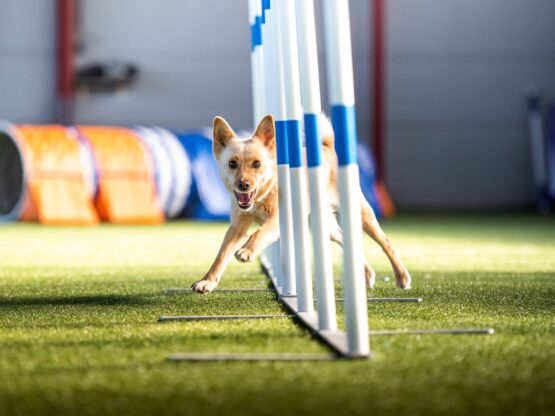
What to bring to agility class
- Comfortable, flat shoes for running
- Six foot leash and flat or training collar
For Rewards
- Soft small treats (ex. hot dogs, cheese) – cut into small, bite size pieces before class. You need a yummy treat to reward the dog quickly and often.
- Toy(s) so that you can reward the dog with play.
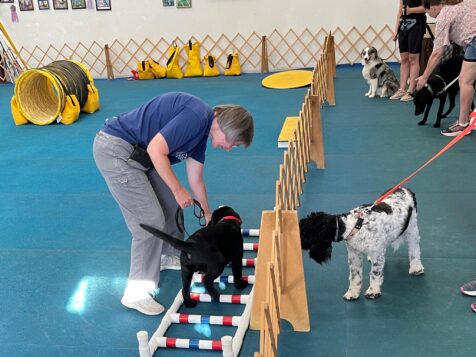
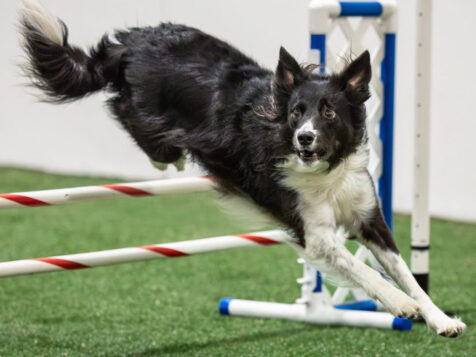
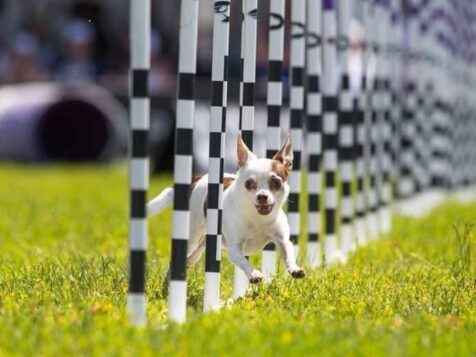
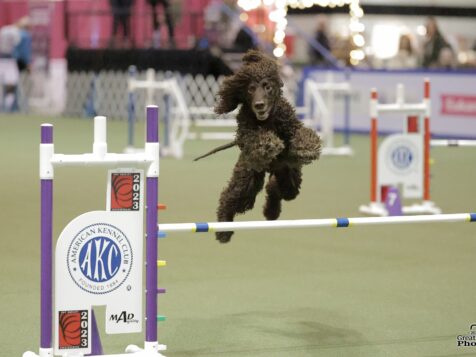
Areas We Serve for Dog Agility Training
Our dog agility training programs are available to pet owners throughout Cape Cod and nearby areas. We proudly serve Bourne, Pocasset, Monument Beach, Cataumet, Falmouth, Mashpee, Forestdale, Sandwich, Sagamore, Cotuit, Osterville, Centerville, Hyannis, Marstons Mills, Barnstable, Yarmouth, Dennis, Onset, Wareham, Cedarville, Marion, Mattapoisett, Carver, Manomet, Rochester, Kingston, Plymouth, Middleborough, and Lakeville.
No matter where you are located if you have been looking for dog agility training near me on Cape Cod, we are here to help your dog succeed.
Ready to unlock your dog’s potential with agility training? At Joseph’s Dog Training School, we’re committed to helping dogs and their handlers build confidence, strength, and focus.
Contact us today to learn more about our agility classes and enroll in the next session. Let’s help your dog thrive in this exciting and rewarding activity!
FAQs About Dog Agility
When can my dog start agility?
Dogs can start agility training at different ages depending on their breed, size, and physical development. Puppies and young dogs should avoid certain movements, exercises, and techniques until they reach full physical maturity, as their bones are soft and growth plates are still developing. At Joseph's Obedience Dog Training, we prioritize the safety and well-being of your dog. Our experienced trainers ensure that puppies are not exposed to any movements that may cause harm and modify training techniques to match their individual capabilities. We take a gradual and tailored approach, allowing puppies to develop the strength and coordination needed for agility activities in a safe and controlled manner, ultimately setting them up for a successful agility journey while preventing any potential injuries.
It's important to note that before starting any agility training, a dog should have a basic obedience training foundation and be in good physical health. It is important to start with basic training and gradually increase the difficulty and complexity of the obstacles as your dog progresses. It's also important to make sure your dog enjoys the training and doesn't get stressed or overwhelmed by it.
Is agility beneficial for the dogs?
Agility training can be very beneficial for dogs both physically and mentally. Here are some of the benefits of agility training for dogs:
- Exercise: Agility training is a great way for dogs to get exercise and burn off energy. It can help improve their cardiovascular health, muscle strength, and endurance.
- Mental stimulation: Agility training requires dogs to use their brains as well as their bodies, which can help improve their focus, problem-solving skills, and overall mental well-being.
- Bonding: Agility training can be a great way to bond with your dog and build trust and teamwork between you and your furry friend.
- Confidence building: As dogs master new obstacles and challenges, their confidence can grow, which can help them in other areas of their lives.
- Fun: Dogs love to play and have fun, and agility training can be a great way to provide them with a fun and exciting activity that they enjoy.
It's important to note that agility training should be introduced gradually and done safely with the guidance of a qualified trainer.
Which dogs are best for agility training?
Any breed or mixed-breed dog can participate in agility training, but some breeds are better suited for this activity due to their athleticism, energy level, and trainability.
Here are some of the dog breeds that are commonly involved in agility training:
- Border Collie: This breed is often considered the best breed for agility training due to their high energy levels, intelligence, and athleticism.
- Australian Shepherd: These dogs are known for their herding abilities and athleticism, which makes them well-suited for agility training.
- Jack Russell Terrier: These dogs are small, but they have a lot of energy and enthusiasm, making them great for agility training.
- Shetland Sheepdog: This breed is agile, intelligent, and trainable, making them popular in agility competitions.
- Golden Retriever: These dogs are not typically associated with agility training, but they are athletic and love to please their owners, making them great candidates for this activity.
- Labrador Retriever: These dogs are also not commonly associated with agility training, but they are intelligent, trainable, and athletic, making them good candidates for this activity.
It's important to note that each dog is unique, and their suitability for agility training depends on their individual temperament, physical ability, and willingness to learn. Any dog can participate in agility training with the right training and guidance from a qualified instructor.
What are the rules of dog agility?
The rules of dog agility can vary slightly depending on the organization or competition, but here are some general rules that are commonly followed:
- Obstacles: The course consists of a set of obstacles, which can include jumps, tunnels, weave poles, A-frame, teeter-totter, dog walk, and others.
- Time limit: The dog and handler must complete the course within a set time limit. Depending on the competition level, the time limit can vary from 35 to 60 seconds.
- Faults: If the dog knocks down a jump bar, misses an obstacle, or performs an obstacle incorrectly, they receive a fault, which adds penalty points to their score.
- Refusals: If the dog hesitates or refuses to perform an obstacle, it is considered a refusal and adds penalty points to their score.
- Scoring: The dog's score is determined by the number of faults and the time taken to complete the course. The dog with the lowest score and fastest time wins.
- Handlers: The handler can use verbal and hand signals to guide the dog through the course but cannot touch the dog or the obstacles.
- Disqualification: The dog can be disqualified for aggressive behavior towards other dogs or the handler, excessive barking, or failure to follow the rules.
These are some of the general rules of dog agility, but specific rules can vary depending on the competition or organization. It's important for handlers to thoroughly understand the rules before participating in a competition.
Can an anxious dog do agility?
It depends on the severity of the dog's anxiety and the individual dog's temperament. In some cases, agility training can help reduce anxiety in dogs by providing them with mental and physical stimulation, boosting their confidence, and building trust between the dog and their handler.
However, if the dog's anxiety is severe, it may not be appropriate to participate in agility training or competitions. In these cases, it's important to consult with a veterinarian or a qualified dog behaviorist to develop a personalized training plan for the dog that takes into account their anxiety.
If the dog is experiencing mild to moderate anxiety, it's important to start with basic training and gradually introduce them to the obstacles in a controlled and positive environment. The handler should use positive reinforcement techniques and avoid punishment-based training methods that can increase anxiety in the dog.
It's also important to keep the dog's stress levels in mind and take breaks as needed. If the dog becomes too anxious or stressed, it's important to stop training and work with a qualified professional to address the dog's anxiety before continuing with agility training.
Are male or female dogs better at agility?
There is no definitive answer to whether male or female dogs are better at agility because the dog's ability to excel in agility training depends on several factors such as breed, size, athleticism, energy level, temperament, and individual personality.
Both male and female dogs can excel in agility training and compete at the highest levels of competition. Some handlers may prefer working with males, while others may prefer working with females based on personal preferences, but this is not an indication of one gender being better than the other in agility training.
It's important to choose a dog for agility training based on their individual characteristics rather than their gender. It's also important to remember that every dog is unique and may have their own strengths and weaknesses when it comes to agility training. What's most important is to work with a dog that has a willingness to learn, a good temperament, and a good level of physical fitness.
What does Q mean in dog agility?
In dog agility, a "Q" (short for "qualifying score") is a term used to indicate that a dog and their handler have successfully completed a course without faults or penalties, and have achieved the minimum time requirement for the course.
In agility competitions, a qualifying score is required to advance to the next level or to earn titles. Typically, a qualifying score is achieved by completing the course within the standard course time, without any faults or penalties, and within the maximum time allowed.
The number of qualifying scores required to advance to the next level or earn a title varies depending on the organization and the level of competition. For example, in the United States, the AKC requires three qualifying scores to earn a Novice Agility (NA) title, while the USDAA requires ten qualifying scores to earn a Master Agility Dog (MAD) title.
Receiving a Q is a significant achievement in dog agility, as it indicates that the dog and handler have successfully navigated the course and have met the required standards for that particular level or competition.
How high should my dog jump in agility?
The height that your dog should jump in agility depends on several factors, including your dog's size, breed, age, and overall health.
In the United States, the American Kennel Club (AKC) and the United States Dog Agility Association (USDAA) have established standard jump heights based on the dog's height at the shoulder. The AKC allows dogs to compete in different jump height categories, ranging from 4 inches to 26 inches. The USDAA offers four jump height categories: 8 inches, 12 inches, 16 inches, and 22 inches.
As a general rule, the jump height should be set so that your dog can easily clear the jump without risking injury. You should consult with your veterinarian and your dog's trainer to determine the appropriate jump height for your dog based on their physical abilities and experience level.
It's also important to note that the height of the jump is just one aspect of agility training. You should focus on building your dog's strength, speed, and agility, as well as teaching them the skills and techniques necessary to successfully navigate the agility course.
How do I build my dog's confidence in agility?
Building your dog's confidence in agility takes time, patience, and consistency. Here are some tips that may help:
- Start with basic obedience training: Before introducing your dog to agility equipment, it's important to have a solid foundation of basic obedience training. This will help your dog understand and follow your commands, which can increase their confidence and reduce stress.
- Use positive reinforcement: Positive reinforcement is a key component of building your dog's confidence. Reward your dog with treats, praise, and playtime when they successfully complete a task or obstacle. This will help them associate agility training with positive experiences.
- Introduce equipment gradually: Introduce agility equipment one piece at a time and gradually increase the difficulty level as your dog becomes more confident. For example, start with a low jump or a tunnel and gradually increase the height of the jump or the length of the tunnel.
- Keep training sessions short and fun: Agility training should be a fun and enjoyable experience for both you and your dog. Keep training sessions short and end on a positive note, even if your dog didn't complete a task perfectly.
- Practice, practice, practice: Consistent practice is important for building your dog's confidence in agility. The more your dog practices and succeeds, the more confident they will become.
- Work with a qualified trainer: Consider working with a qualified agility trainer who can help you and your dog build your skills and confidence in a safe and positive environment.
Remember that every dog is different, and building confidence takes time. Be patient, positive, and consistent, and you and your dog can enjoy the fun and exciting world of agility together.
How long does it take to train a dog for agility?
The length of time it takes to train a dog for agility can vary depending on several factors, including the dog's age, breed, temperament, and level of physical fitness, as well as the trainer's experience and training methods.
Typically, it takes several months to a year or more to train a dog for agility. However, this can vary depending on the goals you have for your dog in agility, as well as your dog's individual learning style and personality.
The first step in agility training is usually basic obedience training, which can take several weeks to several months to master. Once your dog has a good foundation of basic obedience skills, you can start introducing them to agility equipment and exercises.
It's important to remember that agility training is a continuous process, and even experienced agility dogs continue to train and practice regularly to maintain their skills and fitness level.
Overall, the amount of time it takes to train a dog for agility can vary widely depending on the dog and the training program, but with consistent and positive training, most dogs can learn to enjoy and excel at agility.
Does agility tire out a dog?
Yes, agility can tire out a dog both physically and mentally. Agility is a high-energy sport that requires dogs to run, jump, climb, weave, and navigate obstacles quickly and accurately. This requires a significant amount of physical exertion, which can tire out even the most energetic dogs.
In addition to the physical demands, agility also requires dogs to think and problem-solve as they navigate the course, which can be mentally tiring. Dogs must stay focused and alert to the commands and cues of their handler, and adjust their pace and movements as needed to complete the course accurately.
It's important to note that while agility can tire out a dog, it's also a great way to provide mental and physical stimulation, which can help prevent boredom and destructive behaviors. However, it's important to ensure that your dog is properly conditioned and trained for agility to prevent injury and fatigue.
As with any physical activity, it's important to gradually build up your dog's stamina and fitness level, and provide plenty of rest and recovery time between training sessions. You should also provide your dog with plenty of fresh water and take breaks as needed to prevent overheating and dehydration.
Does agility training build confidence in dogs?
Yes, agility training can help build confidence in dogs. Agility training provides dogs with opportunities to learn new skills and overcome obstacles in a positive and supportive environment. As dogs master new skills and complete obstacles successfully, they gain a sense of accomplishment and confidence in their abilities.
Additionally, agility training involves close interaction between dogs and their handlers, which can strengthen the bond between them and increase trust and confidence. Dogs learn to respond to their handler's cues and commands, and to rely on their handler for guidance and support. This can help build a stronger sense of security and confidence in dogs.
Furthermore, agility training can help shy or fearful dogs become more confident and outgoing. As dogs learn to navigate obstacles and interact with other dogs and people in a controlled and positive environment, they may become more confident and comfortable in new situations.
Overall, agility training can be a fun and effective way to build confidence in dogs and strengthen the bond between dogs and their handlers.
Can you train an older dog to do agility?
Yes, older dogs can learn agility and can be successful at it. While it's true that younger dogs tend to be more energetic and physically capable of handling the demands of agility, older dogs can still benefit from and enjoy agility training with some modifications.
When training an older dog for agility, it's important to take into account their age, physical condition, and any health issues they may have. Older dogs may have limitations on the height and intensity of jumps or obstacles, and may need more time to warm up and cool down before and after training.
To train an older dog for agility, it's important to start with basic obedience training and gradually introduce agility equipment and exercises. You should work at a pace that is comfortable for your dog, and allow for plenty of rest and recovery time between training sessions.
It's also important to monitor your older dog's health and wellbeing during agility training, and to adjust the training program as needed to ensure that they are not being overworked or risking injury.
In general, agility training can be a great way to provide older dogs with mental and physical stimulation, and to help keep them active and healthy. With patience, positive reinforcement, and appropriate modifications, older dogs can learn agility and enjoy the benefits of this fun and challenging sport.
